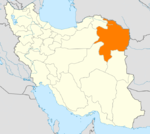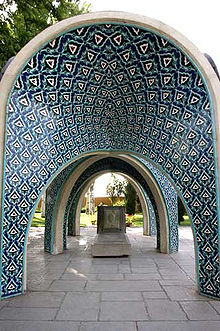- Nishapur
-
For the administrative subdivision, see Nishapur County.
Nishapur
نیشابور
NishaburNishapur Night City Nickname(s): Abarshahr, Turquoise Town, City of Imam Reza, Night city[1] Coordinates: 36°12′48″N 58°47′45″E / 36.21333°N 58.79583°ECoordinates: 36°12′48″N 58°47′45″E / 36.21333°N 58.79583°E Country  Iran
IranProvince Razavi Khorasan County Nishapur County Bakhsh Central Shahpur Elevation 1,250 m (4,101 ft) Population (2006) – Total 205,972 Census Time zone IRST (UTC+3:30) Website Neyshaboor Nishapur or Nishabur (Persian: نیشاپور, also Romanized as Nīshāpūr, Nīshābūr, and Neyshābūr),[2] is a city in the Razavi Khorasan province in northeastern Iran, situated in a fertile plain at the foot of the Binalud Mountains, near the regional capital of Mashhad. Nishapur derived its name from its alleged founder, the Sasanian king Shapur.
The region's economy is largely agricultural, based on grain and cotton, and it is also the second industrial city in Khorasan, and it is one of the most prosperous localities in Iran, although somewhat blighted by drug smuggling from nearby Afghanistan. It had a population of 205,972 people according to 2006 census.[3] The main east-west railway line through Iran passes through the town. The region is very prone to earthquakes, with the most recent significant ones occurring in 1986 and 1997.
Contents
History
Main article: History of NishapurNishapur occupies an important strategic position astride the old Silk Road that linked Anatolia and the Mediterranean with China. On the Silk Road, Nishapur has often defined the flexible frontier between the Iranian plateau and Central Asia. The town derived its name from its reputed founder, the Sassanian king Shapur I, who is said to have established it in the 3rd century CE. Nearby are the turquoise mines that supplied the world with turquoise for at least two millennia. It became an important town in the Khorasan region but subsequently declined in significance until a revival in its fortunes in 9th century under the Tahirid dynasty, when the glazed ceramics of Nishapur formed an important item of trade to the west. For a time Nishapur rivaled Baghdad or Cairo: Toghrül, the first ruler of the Seljuk dynasty, made Nishapur his residence in 1037 and proclaimed himself sultan there, but it declined thereafter, as Seljuk fortunes were concentrated in the west. In the year 1000CE, it was among the 10 largest cities on earth.[4] After the husband of Genghis Khan's daughter was killed at Nishapur in 1221, she ordered the death of all in the city (~1.7 million), and the skulls of men, women, and children were piled in pyramids by the Mongols. This invasion and earthquakes destroyed the pottery kilns. In 1979, the 15th World Scout Jamboree was scheduled to be held in Nishapur, but it was cancelled because of the uprising against the Shah of Iran led by Khomeini Ayatollah.
Culture
Nishapur is also home to many poets and cultural celebrities. The poet and mathematician Omar Khayyám was born in Nishapur in 1048 and is buried a few miles outside the town, near the Imamzadeh Mahroq Mosque. The 12th century poet and mystic Farid al-Din Attar, another native of Nishapur, is also buried nearby. And Iran's greatest contemporary painter, Kamal-ol-molk is buried in the same place. Also Nishapur has been the hometown of famous people including:
- Muslim ibn al-Hajjaj (one of Islam's greatest muhaddiths, whose collection of hadith, Sahih Muslim, is second in authenticity only to Muhammad al-Bukhari's Sahih al-Bukhari)
- Imam al-Hakim (another one of Islam's greatest muhaddiths and scholarly giants)
- Prof. Mohammad Reza Shafiei-Kadkani (great contemporary Persian poet and writer and Persian literature Professor, who is famous for his literary criticism)
- Ostad Parviz Meshkatian (famous Musician, researcher, Santur player and composer).
- Heydar Yaghma (an illiterate worker who began telling poems and published them.)
- Haji Bektash Veli (Muslim mystic, humanist and philosopher)
- Saadat Khan or Wakil-i-Mutlaq, Saadat Khan also called Burhan-ul-Mulk, was the founder of the Awadh dynasty in north India in 18th century.
Popular culture
US band Santana released an instrumental track entitled "Incident at Neshabur" on their 1970 LP release, Abraxas.
Archaeology sites
Little archaeology has been done on this vast and complicated site. George Curzon remarked that Nishapur had been destroyed and rebuilt more times than any other city in history, an evocative statement whether or not it is statistically true. The Metropolitan Museum of Art undertook excavations from 1935 that were interrupted in 1940. Searching largely for museum-worthy trophies that they shared with the government of the Shah, the Metropolitan's publications were limited to its own Nishapur ceramics. The site of Nishapur has been ransacked for half a century since World War II, to feed the international market demand for early Islamic works of art.
Shadiyakh
Shadiyakh (in Persian: شادیاخ, a contracted form of شادی کاخ, Shadi-Kakh or Palace of Happiness) was one of the main palaces of old Nishapur up to the 9th century AD, which became more important and populated after that. Some notable people like Attar lived there. Attar's tomb is nowadays in that area. This palace was perhaps completely ruined in 13th century AD.
ٍExcavations began in 2000 there and continued for around 2 years: buildings (possibly a palace), skeleton, equipments and other items were found there.
Recent incidents
- In the Summer of 1987 (24.7.1987), a flood in Boojan village killed over 1,000 people and destroyed some villages.
- On February 18, 2004, in the Nishapur train disaster, a train carrying flammable goods derailed and caught fire near the town. Five hours later, during fire fighting and rescue work, a massive explosion destroyed the train and many nearby buildings. Around 300 people were said to have been killed, mainly fire and rescue workers but also the local governor and mayor and the heads of the fire and rail services.[5]
Souvenirs
The most important Nishapur souvenirs include turquoise and rhubarb.
Neyshabur Turquoise has been used for more than 2000 years and for this turquoise it is sometimes called "the turquoise land". Neyshabur turquoise and jewellery made from it are sold as souvenirs in Neyshabur and Mashhad resorts.
Rhubarb (Persian rivaas or rivand), a sour vegetable, grows at the foot of the eponymous Rivand Mountains (more recently, Turkified as Mount Binalud). Soft drinks made from the stems of the plant, such as "Sharbate rivaas" (in Persian:شربت ریواس) and "Khoshaabe rivaas" (in Persian:خوشاب ریواس), are sold at some Nishapur resorts as souvenirs.
Sister cities
 Kairouan, Tunisia
Kairouan, Tunisia Baghdad, Iraq
Baghdad, Iraq Basra, Iraq
Basra, Iraq Ghazni, Afghanistan
Ghazni, Afghanistan Balkh, Afghanistan
Balkh, Afghanistan Herat, Afghanistan
Herat, Afghanistan Merv, Turkmenistan
Merv, Turkmenistan Bukhara, Uzbekistan
Bukhara, Uzbekistan Samarqand, Uzbekistan
Samarqand, Uzbekistan Khiva, Uzbekistan
Khiva, Uzbekistan Tajikistan, Khojand[6]
Tajikistan, Khojand[6]
External links
- Nishapur Mayors (Persian)
- Nishapur governors (Persian)
- Ceramics of Nishapur and other centers
- World Gazetteer on Nishapur
- Neyshaburian e-newspaper (Persian)
- A useful weblog about Nishapur (Persian)
- wooden village website
- Nishapur Mathhouse
- Neyshabur bonyad (Persian)
- Elias Pirasteh, Neyshabur, Photo Set, flickr
- Ardavan Ruzbeh, When National Heritage is not an equal to the Emām-Jom'eh, a reportage on the demolition of a national monument, Madreseh-ye Golshan (مدرسه گلشن), in Nishabur, in Persian, Radio Zamāneh, May 29, 2008: Text, Audio.
- Hossein Davoudi, Dizbād: A Staircase to History, in Persian, Jadid Online, 2008, [1].
A Slide Show of Dizbād, by Hossein Davoudi, Jadid Online, 2008, [2] (5 min 39 sec).
Note: Dizbād is a small village between Mashhad and Neyshābūr, located at some 40 km distance from Mashhad.
References
- ^ metmuseum.org
- ^ Nishapur can be found at GEOnet Names Server, at this link, by opening the Advanced Search box, entering "-3076915" in the "Unique Feature Id" form, and clicking on "Search Database".
- ^ "Iran Census" (in Persian). http://www.amar.org.ir/DesktopModules/FTPManager/upload/upload2360/newjkh/newjkh/Q11.xls.
- ^ geography.about.com
- ^ news.bbc.co.uk
- ^ this Section About a Governmental Document of Nishapur Municipality.Nishapur Mayor said in 2002 this cities are Nishapur's Sister Cities
 Razavi Khorasan Province
Razavi Khorasan ProvinceCapital 
Counties (A-R) and Cities Bajestan CountyBajestan • YunesiBakharz CountyBardaskan • Anabad • ShahrabadFariman • Farhadgerd • Qalandarabad • Sefid SangFiruzeh CountyFiruzeh • HemmatabadGonabad • Bidokht • KakhkJoghatai CountyJoghataiJowayin CountyKalat • Shahr-e ZowKashmar • RivashKhalilabad • KondorKhoshab CountySoltanabadKhvaf CountyKhvaf • Nashtifan • Qasemabad • Salami • SanganFeyzabad • ShadmehrQuchan • BajgiranRashtkhvar CountyRashtkhvar • JangalCounties (S-Z) and Cities Taybad • Kariz • Mashhad RizehTorbat-e Heydarieh • Bayg • Kadkan • Robat-e SangTorqabeh and Shandiz CountyTorqabeh • ShandizZave CountyLandmarks Imam Reza shrine · Goharshad Mosque · Tus citadel · Kooh Sangi · Akhlamad · Mount Binalud · Zist-e Khavar · Kian Center · Azar Barzin Mehr fire temple,Sabzevar · Ferdowsi's mausoleum in Tus · Haruniyeh Dome in Tus · Tomb of Farid ad-Din Attar,Nishapur · Kohandezh, Nishapur · Tomb of Omar Khayyám, Nishapur ·Architecture of Iran Styles Parsi style · (includes Pre-Parsi style and Achaemenid architecture)
Parthian style · (includes Sassanid architecture)
Khorasani style · Razi style · Azari style · Isfahani style
Elements Notable traditional cities Architecture of Tehran · Bam · Bukhara · Ctesiphon · Derbent · Herat · Isfahan · Kashan · Merv · Mashhad · · Nishapur · Persepolis · Qazvin · Qom · Samarkand · Shahrisabz · Shiraz · Susa · Tabriz · Takht-i-Suleiman · Yazd · Gur-e AmirTheory and Analysis Lists Categories:- Cities in Iran
- Nishapur County
- Khorasan
- Nishapur
- Cities in Razavi Khorasan Province
- Populated places along the Silk Road
- Seljuq dynasty
- Tahirid dynasty
- Ancient cities
- Iranian archeological cities
- Archaeological sites in Iran
- Nishapur Quarter
- Ismaili centres
Wikimedia Foundation. 2010.






